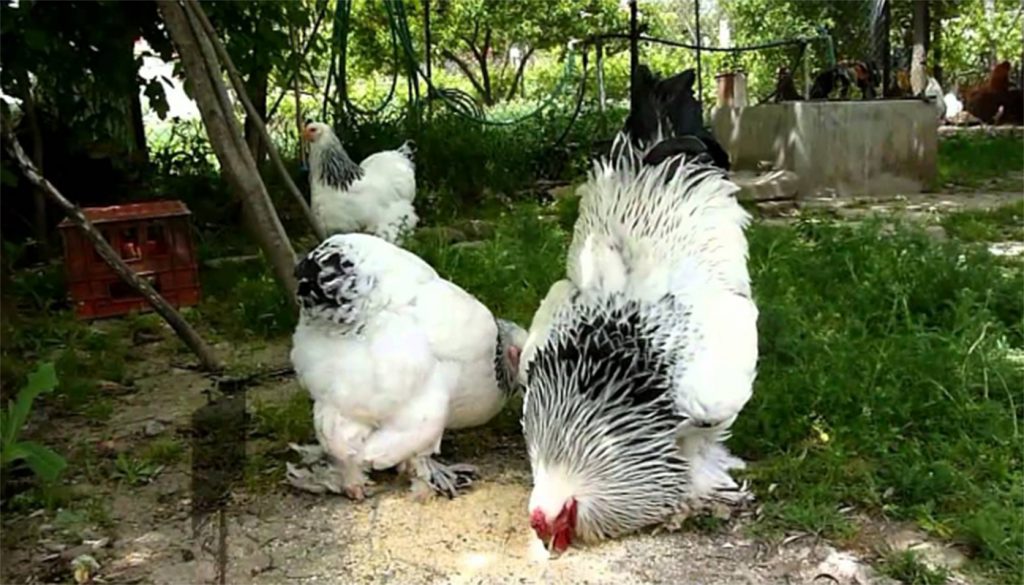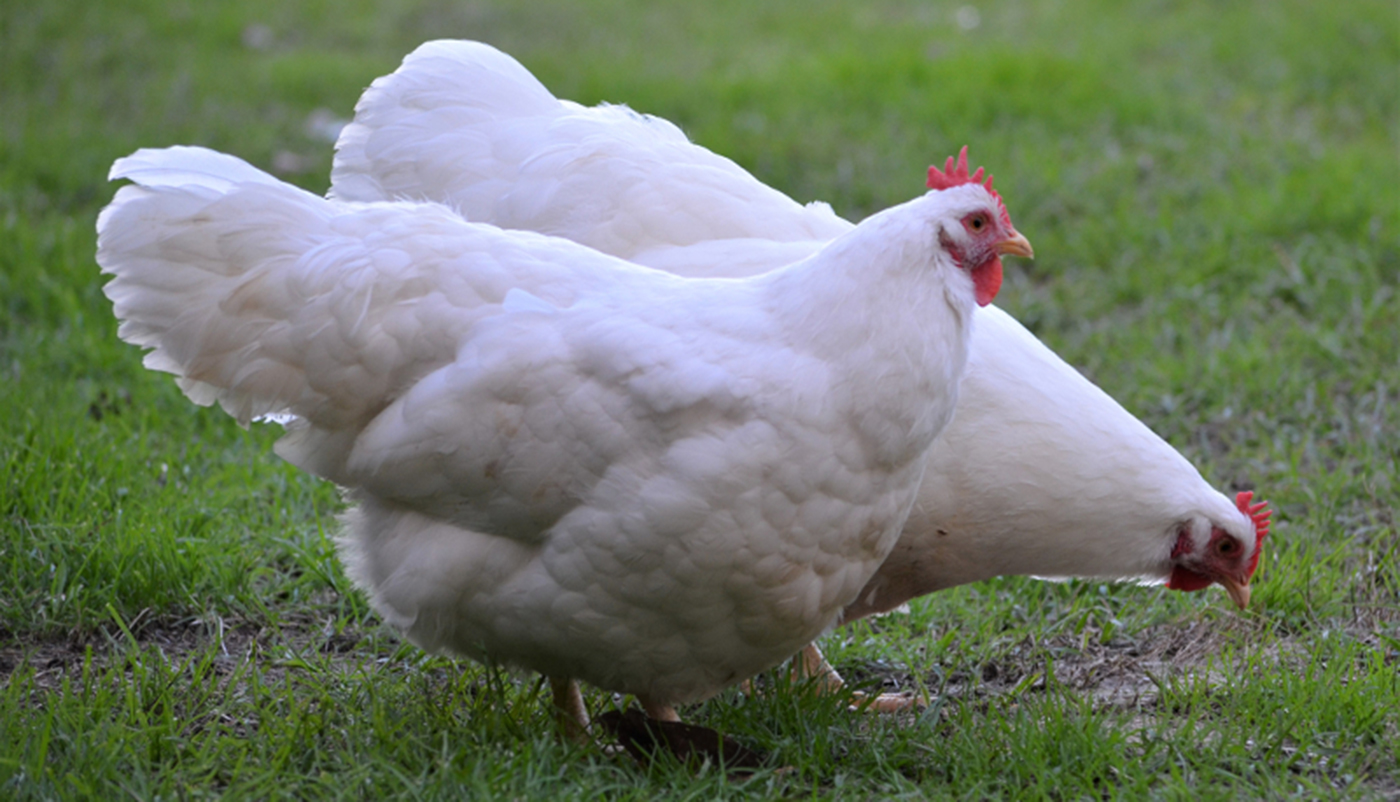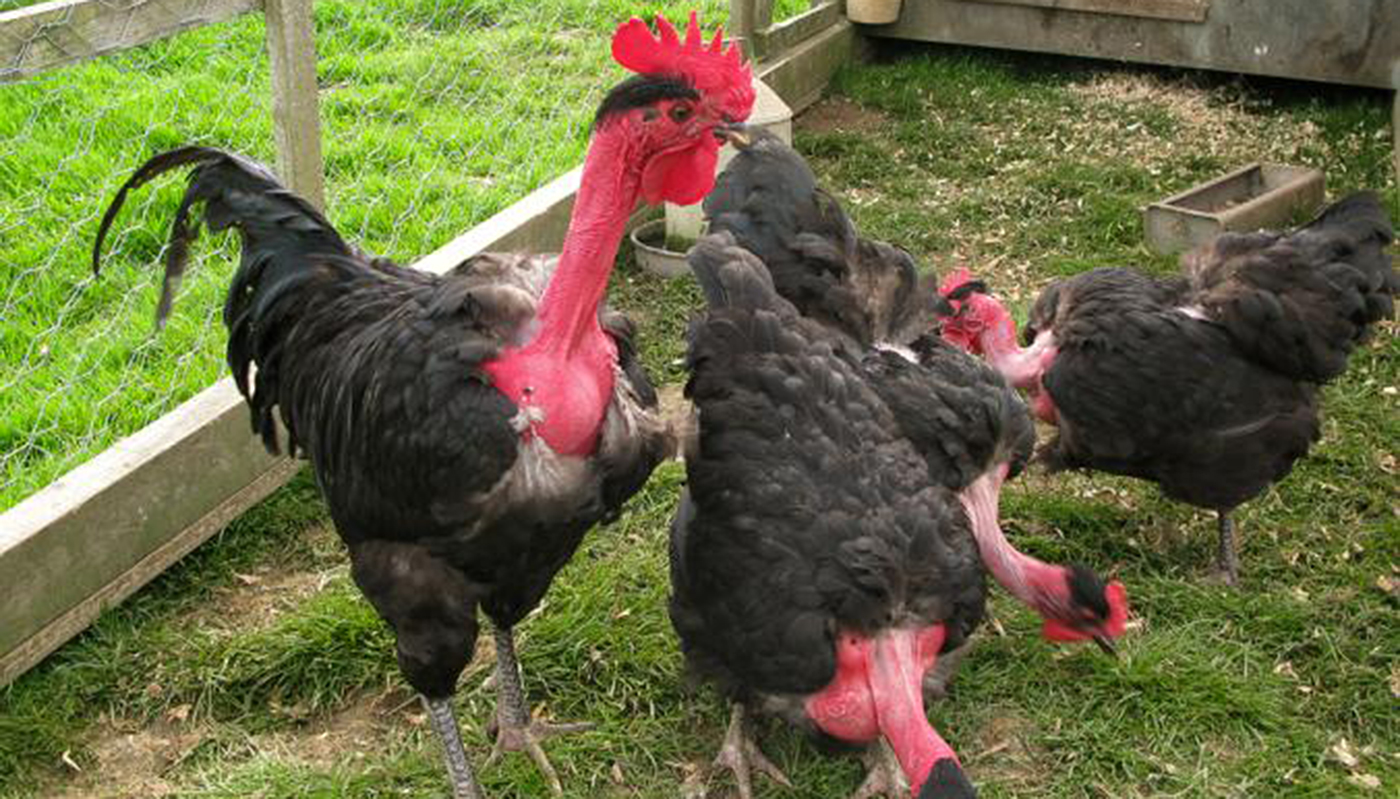
A very majestic chicken that does tend to like to be top of the pecking order. Due to its size (nearly as big as the Jersey Giant) these gentle giants usually reign supreme at the top. Their gently calm and almost diplomatic nature make these birds a pleasure to have in any flock. These birds can get to around 30 inches tall standing tall and proud they glide around the garden.
| Country of Origin: | America |
| American Poultry Association: | Recognized as a breed of chicken in the United States |
| Chicken Category: | Large Breed |
| Chicken Class: | Asiatic |
| Bantam Variety Available? | Yes – Feather Legged Bantam Classification |
| Related | TOP 10 BANTAM CHICKEN BREEDS FOR BEGINNERS |
| Good Starter Chicken? | They are a low maintenance chicken with a nature that makes them perfect as a starter chicken. |
| Related | 10 BEST STARTER CHICKENS FOR THE FIRST TIME POULTRY KEEPER |
PURPOSE⇒ |
Eggs: They are very good egg layers.
They lay large brown eggs from 180 – 240 per year They will lay consistently throughout winter and summer They start to lay eggs from around 16 to 20 22 weeks old.
Meat: They have yellow meat which is tender at all ages and are an excellent table bird
Breeding: They can be bred and they hens do get broody they are also excellent mothers and brood hens. If you are breeding the Brahma for show choosing the correct hens and rooster bloodline is crucial.
Foraging: They love to scratch and forage about. But do well in confinement.
Show Bird: Their magnificent plumage, regal bearing and size make them excellent show birds.
Pets: Their sweet docile calm natures make them excellent pets
Other: These lovely ladies will lead the flock around the garden enjoying the day as they peck about at the pests.
|
| Flyers? | Due to their size, they are not very good flyers. |
| Noisy Birds? | They can be noisy but in general, prefers a nice quiet day |
| Interaction with other chickens: | They get along well with other breeds. As with any flock if you are introducing new birds it is best to slowly socialize them with the flock. |
| Good with kids? | Their gentle calm nature makes them a great pet to have around children. |
| Related | 10 ROOSTER BREEDS THAT DO NOT MIND CHILDREN |
HISTORY
There is a bit of a debate on the origins of the Brahma. Although the chicken is believed to have been developed in the United States the origins of the breeds from which it was developed is unclear. The main consensus is that the Brahma was created from chickens that were imported from the port of Shanghai in China. These chickens were knowns as “Shanghai birds” and are believed to have been bred with the Chittagong chickens from Bangladesh. The Chittagong is what could have been responsible for the Brahma’s distinctive shaped head and pea comb. This distinction is what separates the breed from another breed that originated from the “Shanghai birds” called the Cochin.
The Brahma is an old breed of bird in the USA and was the prime meat bird in the country from the mid-1800’s right up until the 1930’s.
There are three varieties that are recognized by the American Standard of Perfection. The light and dark color variations were accepted by the American Poultry Association in 1874 and the Buff variety was only added between 1924 and 1929.
As they are not fast growers and the hens can take up to six to seven months old before they start laying the Brahma was replaced as a popular table bird by large production companies. Thus, the bird’s popularity declined, and its number dropped considerably it is now listed on the conservation list as watch and in some counties recovering as more breeders are taking an interest in the beautiful heritage breed.
CHARACTERISTICS |
|
|---|---|
IDENTIFICATION⇒ |
Appearance/Body: These beautiful large ladies have exaggerated tail feathers, a beautiful abundance of plumage and feathered legs and feet. The gorgeous red faces have a beetle brow with a pea comb making them look like royalty. They have a serious expression topped with reddish-bay colored eyes and bright red wattles and earlobes.
Color(s)⇒
1: Light – primarily white, greyish, sickle feather have a black stripe, the tail is black with white laced. 2: Dark – the females’ hackles are black with slight grey pencilling and white. The body and wings are a light grey with black edges. The dark males have silver hackles with a black striped saddle. Tail, body and breast should be solid black. 3: Buff – the color is the same as the light only a buff color is where there would be white in the light color.
Comb: They have a pea comb
Ave. Weight: Pullet/Hen 8 – 10 lbs.
Cockerel/Rooster 10 – 12 lbs. |
| Life Expectancy: | The average lifespan is 8 – 12 years |
| Health: | They have no known health issues and are quite a hardy bird. But due to their feathered feet and legs, they need to be watched and even cleaned in the winter. The feathers on their feet can get muddy, cold and lead to frostbite or other foot diseases. In the summer months, they need a lot of cool water and shade due to their excess plumage. |
| You may Also Like: | HOW TO TELL IS A CHICKEN IS SICK |
| Temperament: | Gentle calm, docile and mothering giants. |
| Socialize Behavior? | They get along well with all other animals |
| You may Also Like: | HOW TO SOCIALIZING YOUR NEW CHICKENS |
| Known predators: | Most domestic animals leave them alone as they are large birds, but it is always best to keep an eye on dogs and cats. If hawks and or foxes are in your area it is always best to take precautions. Although they are not an easy target for most feathery predators. Check with local animal shelters, zoos, vets, animal control and or pet stores about common predators in your area. |
| Conservation Status: | These birds conservation status is recorded as “watch/recovering”. It is best to check on any special license or instructions that may be set up for owning these birds. This can be checked with your local or national conservation centers. |
IDEAL ENVIRONMENT |
|
|---|---|
| Garden Size: | They adapt well to most sized gardens and take confinement well. They do like to free range and forage about to stretch their powerful yellow legs. |
| Ideal Climate: | They are very hardy birds that handle the cold very well and as long as there is a lot of shady spots and nice cool water summer is not a problem for these well feathered gentle giants. |
| Ideal Coop: | The rule of thumb for any coop is 50 cm x 50 cm per hen/rooster in the coop. Ensure there is a good space for the nesting boxes and nightly roosting rails at least 1.5 inches wide. Good ventilation for air but not too drafty especially in winter. It is always a good idea to raise the coop off the ground to give the birds a dry place to roost and lay especially in wet weather. |
| Ideal Coop Run: | Brahma are big chickens and they do not tend to fly. Although it should not be necessary to fully over the coop run it is always advisable in order to give the birds a safe secure environment. |
| Ideal Flock Size: | They are quite happy in any size flock as long as they have one companion to wander the gardens with. |
| Special Instructions: | Their foot and leg feathers may need a bit of care especially in cold, damp and muddy environments. |
| Accessories: | The following accessories are ideal for your coop: Nesting boxes Straw for the boxes and roosting area Roosting rails Perches Water troughs/bowls Food bowls/feeders Heating lamp(s) Animal carrier for transport purposes |
| You may Also Like: | 45 FREE DIY CHICKEN COOP PLANS, TUTORIALS AND DESIGNS |
WHERE TO FIND THESE BIRDS TO ADD TO YOUR FLOCK
The Brahma was once America’s prime source of meat up until the early 1930’s. Their decline in numbers was a source of concern for the Poultry conservation but in recent years there has been a lot of interest in these heritage birds. Their numbers are slowly increasing and although you may very well be able to find these chickens for sale at some live poultry outlets and farms, it is best to check with your local conservation centers and registered breeders. You can find registered breeders on the American Brahma Club website along with a host of valuable information. They will also be able to help with any special requirements, attention or care they may need. If you plan on breeding your chickens, you will want to make sure that they are from a good bloodline.
CARING FOR THE BIRD(S)
Please click here for our full guide to “Taking care of chickens”. This is a comprehensive guide to owning chickens. It covers where to start from choosing your ideal flock, the coop that would best suit your garden, your bird and you to buying and bringing your bird(s) home.
GENERAL
Except for their feathers, they are a low maintenance bird and their size tends to deter predators. These gentle giants have a calming regal influence on a flock.
GROOMING
Their full plumage and feathered legs/feet need to be taken care of. Especially their feet and legs if there is a log of damp or mud about.
These chickens do love their dust bath and will love some added herbal essences mixed into the loose sand to help with pests and excess feather oils. As big as they are they do adore attention and these gentle creatures will have no objection to a regular examination for mites, lice and various other parasites. Checking for these pests in their feathers should be done at least once a week to your chickens healthy. Always get your birds de-wormed on a regular basis especially if they are around other animals or interacting with kids.
DIET AND NUTRITION
Give your Brahma a balanced diet of chicken pellets, grains, chicken mash or grain mix from 8 weeks old and older. This should be fed to them first thing in the morning before they are let out to roam about to ensure they are getting all their nutrients.
For baby chickens, the best is always Chick Starter when they are under 8 weeks old.
Laying hens should get extra protein and calcium in their diets to ensure the quality of their eggs and to keep them in tip-top health.
Brahma does love getting table scraps in the form of vegetables and fruit. They find these scraps even better if they are served as ice-cubes on very hot days.
Feeding your chickens correctly will give your organic garden a lot of nutritious fertilizer to make your vegetables or flowers grow.
Please see our comprehensive guide to “Feeding your chickens” for more information of the different types of chicken feed for chicks, hens, laying hens, roosters, etc. and where to buy the feed and approximate cost of the feed.
SOCIALIZING THE BIRD(S)
Brahma is not a difficult bird to socialize as their sheer size tends to make other breeds shy away from challenging the pecking order. However, some smaller birds may be a lot more aggressive and there could be serious consequences.
Always check on how well a breed will get on with your current flock before buying them as you do not want to upset your coop or stress your current flock.
If you want to introduce another breed with your Brahma, try a breed that has a gentle nature that will match theirs.
As with any newcomer to the roost, you will have to quarantine the bird for 7 – 31 days to ensure it does not have any unwanted critters or disease that could spread to your current flock.
Even though they are gentle sociable birds, even they have a pecking order, so it is advisable to socialize them slowly and determine when it is right to allow them to become a permanent part of the flock.
NOTES / SPECIAL INSTRUCTIONS
As they are registered as a “recovering/watch” conservation status they may need an extra license to own or keep in your garden. For advice on what the bird’s conservation status and orders are please check with your local conservation department.
For breeders, it is imperative that you always check your bird’s bloodlines and ensure you are buying your birds from a reputed breeder/farm. In order to sell birds of such stature, they have to be recorded and documented, always check with local animal breeding organizations for these records.
These legitimate documents are also required should you wish to show your bird(s) in various poultry shows/competition showings.
For information and advice on adopting rescued animals, you can visit or contact your local animal welfare center.
Video
USEFUL LINKS
- Caring for your Chicken
- Feeding
- Health
- Socializing your Chicken
- Breeding Chicken
- Raising Chickens A-Z
- Hatching Eggs
- What is Molting
- Animal Shelter (ASPCA)
- American Veterinary Medical Association
- American Poultry Association
- American Animal Welfare Society
- American Animal Control
- American Animal Husbandry Society
References
- https://en.wikipedia.org
- https://livestockconservancy.org
- https://www.roysfarm.com
- https://www.mypetchicken.com
- https://www.backyardchickens.com
- https://www.feathersite.com/
 Lamona Chicken Breed – Everything You Need to Know
Lamona Chicken Breed – Everything You Need to Know Common Digestive Disorders in Chickens: Symptoms, Treatment, and Prevention
Common Digestive Disorders in Chickens: Symptoms, Treatment, and Prevention Langshan Chicken Breed – Everything You Need to Know
Langshan Chicken Breed – Everything You Need to Know TO HATCH OR NOT TO HATCH? – HATCHING EGGS PART 1
TO HATCH OR NOT TO HATCH? – HATCHING EGGS PART 1 10 Chicken Breeds that have White Plumage
10 Chicken Breeds that have White Plumage CONDITIONS THAT AFFECT THE EYES OF A CHICKEN
CONDITIONS THAT AFFECT THE EYES OF A CHICKEN Malay Chicken Breed – Everything You Need to Know
Malay Chicken Breed – Everything You Need to Know Naked Neck Chicken Breed – Everything You Need to Know
Naked Neck Chicken Breed – Everything You Need to Know 80+ Best Chicken Coops and Runs to Buy
80+ Best Chicken Coops and Runs to Buy The Zodiac of Chickens: Matching Chicken Breeds to Astrological Signs
The Zodiac of Chickens: Matching Chicken Breeds to Astrological Signs Sicilian Buttercup Chicken Breed – Everything You Need to Know
Sicilian Buttercup Chicken Breed – Everything You Need to Know Understanding Chicken Stress: Causes and Solutions | Tips for Happy Flocks
Understanding Chicken Stress: Causes and Solutions | Tips for Happy Flocks